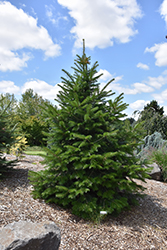It's all about ...
plants

Height: 70 feet
Spread: 30 feet
Sunlight:
![]()
![]()
Hardiness Zone: 8b
Other Names: West Himalayan Fir
Description:
A beautiful and adaptable fir tree, with outstanding bright green color and a neat, narrow, spire-like shape with short branches; excellent for articulation and color in the landscape
Ornamental Features
Pindrow Fir is primarily valued in the landscape for its distinctively pyramidal habit of growth. It has attractive green foliage with grayish green undersides and tinges of silver which emerges light green in spring. The needles are highly ornamental and remain green throughout the winter. The deep purple fruits which fade to brown over time are held in cones from early summer to late fall. The smooth gray bark adds an interesting dimension to the landscape.
Landscape Attributes
Pindrow Fir is an evergreen tree with a strong central leader and a distinctive and refined pyramidal form. Its average texture blends into the landscape, but can be balanced by one or two finer or coarser trees or shrubs for an effective composition.
This is a relatively low maintenance tree, and usually looks its best without pruning, although it will tolerate pruning. It has no significant negative characteristics.
Pindrow Fir is recommended for the following landscape applications;
- Accent
- Vertical Accent
Planting & Growing
Pindrow Fir will grow to be about 70 feet tall at maturity, with a spread of 30 feet. It has a low canopy with a typical clearance of 3 feet from the ground, and should not be planted underneath power lines. It grows at a medium rate, and under ideal conditions can be expected to live for 80 years or more.
This tree does best in full sun to partial shade. It prefers to grow in average to moist conditions, and shouldn't be allowed to dry out. It is not particular as to soil type or pH. It is somewhat tolerant of urban pollution, and will benefit from being planted in a relatively sheltered location. Consider applying a thick mulch around the root zone in winter to protect it in exposed locations or colder microclimates. This species is not originally from North America..
This plant is not reliably hardy in our region, and certain restrictions may apply; contact the store for more information.
